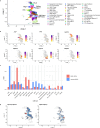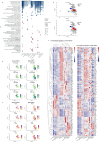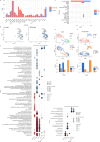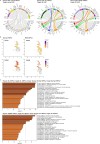Genotype-integrated single-cell transcriptome analysis reveals the role of DDX41 pR525H in a patient with myelodysplastic neoplasms
- PMID: 40596075
- PMCID: PMC12218040
- DOI: 10.1038/s41598-025-06477-w
Genotype-integrated single-cell transcriptome analysis reveals the role of DDX41 pR525H in a patient with myelodysplastic neoplasms
Abstract
DEAD-box helicase 41 (DDX41) is implicated in germline (GL)-predisposed myeloid neoplasms, where pathogenic GL variants often lead to disease following the acquisition of a somatic variant in trans, most commonly p.R525H. However, the precise molecular mechanisms by which DDX41 variants contribute to the pathogenesis of myeloid neoplasms remain poorly understood, partly due to challenges in establishing cellular and animal models that faithfully recapitulate the human disease phenotype. This limitation highlights the necessity of directly analyzing primary human disease cells. In this case report, conducted to pursue this objective, we implemented single-cell RNA sequencing integrated with genotyping at the p.R525 locus in a myelodysplastic neoplasm (MDS) harboring both germline and somatic DDX41 variants, leveraging highly efficient Terminator-Assisted Solid-phase cDNA amplification and sequencing. We found that acquiring p.R525H induced G2/M cell cycle arrest selectively in colony-forming unit-erythroid cells, accompanied by R-loop accumulation, which impaired erythropoiesis through DNA damage. In hematopoietic stem and myeloid progenitor populations, gene expression profiles were largely similar between p.R525H-positive and -negative cells. However, ligand-receptor interaction and transcriptional regulation analyses suggested a non-cell-autonomous influence from p.R525H-expressing cells on GL variant-only cells. This interaction drove convergence toward a shared expression profile, highlighting an intricate interplay shaping the patient's MDS phenotype.
Keywords: DDX41; Cell-cycle arrest; Myeloid neoplasms with germline predisposition; Single-cell transcriptome; p.R525H variant.
© 2025. The Author(s).
Conflict of interest statement
Declarations. Competing interests: S.S. reports an advisory role for ImmunoGeneTeqs, Inc.; stock for ImmunoGeneTeqs, Inc. but declares no non-financial competing interests. H.M. serves as a member of the journal’s editorial board. The other authors declare no financial or non-financial competing interests.
Figures






Similar articles
-
Clinicopathological and prognostic significance of DDX41 mutation in myeloid neoplasms: a systematic review and meta-analysis.Ann Hematol. 2025 May;104(5):2581-2591. doi: 10.1007/s00277-025-06278-1. Epub 2025 Apr 21. Ann Hematol. 2025. PMID: 40257479 Free PMC article.
-
Comprehensive single-cell chromatin and transcriptomic profiling of peripheral immune cells in nonsegmental vitiligo.Br J Dermatol. 2025 Jun 20;193(1):115-124. doi: 10.1093/bjd/ljaf041. Br J Dermatol. 2025. PMID: 39888372
-
Thrombopoietin mimetics for patients with myelodysplastic syndromes.Cochrane Database Syst Rev. 2017 Sep 30;9(9):CD009883. doi: 10.1002/14651858.CD009883.pub2. Cochrane Database Syst Rev. 2017. PMID: 28962071 Free PMC article.
-
Systemic pharmacological treatments for chronic plaque psoriasis: a network meta-analysis.Cochrane Database Syst Rev. 2021 Apr 19;4(4):CD011535. doi: 10.1002/14651858.CD011535.pub4. Cochrane Database Syst Rev. 2021. Update in: Cochrane Database Syst Rev. 2022 May 23;5:CD011535. doi: 10.1002/14651858.CD011535.pub5. PMID: 33871055 Free PMC article. Updated.
-
Granulocyte and granulocyte-macrophage colony stimulating factors for newly diagnosed patients with myelodysplastic syndromes.Cochrane Database Syst Rev. 2016 Feb 16;2(2):CD009310. doi: 10.1002/14651858.CD009310.pub2. Cochrane Database Syst Rev. 2016. PMID: 26880256 Free PMC article.
References
Publication types
MeSH terms
Substances
Grants and funding
LinkOut - more resources
Full Text Sources
Medical
Research Materials
Miscellaneous

